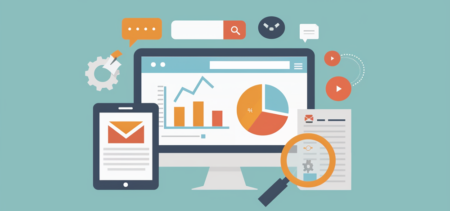Every marketer today has heard about marketing automation at least once. And the interest in this strategy seems to be growing exponentially. According to Google Trends, the search traffic for „marketing automation” has gone up to 40% since last year.
But what is marketing automation all about?
This technology can help businesses target prospects and clients using automated messages on a series of different platforms, across email, web, and on social media. These automated messages and texts are sent automatically in workflows that are set using pre-established instructions and conditions.
Using automation leads to better results in your lead generation, nurturing, and overall campaign ROI. The time and cost-saving effects are also great benefits when implementing a marketing strategy where you don’t need to manually send every email, message, campaign, or post you create for your audience.
When you go on a search engine and look up the term „marketing automation”, the first results you get are referring to marketing automation software providers. These are different software platforms and technologies that can help companies focus their marketing efforts on different online channels such as email, website, and social media.
The purpose of a marketing automation platform is to replace any time-consuming, repetitive manual processes with automated, time-saving solutions.
Let’s take a look at when and where automation implementation is appropriate.
Collect big data and make smarter decisions
Marketing automation is the perfect strategy that can help you embrace big data effortlessly. You can do that by collecting valuable insights and using them to make smarter business decisions.
Automation software platforms are a comprehensive solution for measuring marketing and predicting customer behavior on a low budget. What makes them so effective? Their ability to collect and store big data, report insights, and the analytics they provide.
Get your sales and marketing departments on the same page
Automation can dramatically impact the performance of both the sales and marketing departments and deliver real benefits, such as:
- Effectiveness: your teams can grow to be much more effective using real-time notifications, prospect tracking, and improved sales intelligence.
- More bandwidth: through the automation of repetitive tasks, your teams get more bandwidth to focus on other important projects.
- Clarity: you can increase the transparency and accountability with accurate reporting
Increase efficiency
The main purpose of automation is to save you and your teams time by enhancing your efficiency. For example, in email marketing, you can leverage an automation tool to track and deal with your unsubscribers, send responses, and generate analytic reports. In social media, you can automatically schedule or post your ads and messages.
Simply put, marketing automation can save you precious time on most repetitive tasks that would require manual processes.
Reduce errors
When tasks are being rushed and there is no time to double-check your work, errors can slip through your hands. The same happens when tasks are too repetitive—the person can lose focus, and that’s when mistakes occur.
This is a great time to implement automation—the right marketing tool can help you reduce these errors.
Improve customer journeys
Use marketing automation to create seamless customer journeys through your brand’s touchpoints and tailor every interaction based on the data you have on your clients.
You can create content and messages that reach your customers along their journey, whether they are in the acquisition or the advocacy process. Delivering timely, relevant content when, where, and how your customers prefer it gives you a higher chance to accomplish more successful conversions.
Marketing automation—best practices
- Define your goals to justify the investment into a marketing automation platform.
- Collaborate with other teams inside your organization.
- Detail your workflows to get the bigger picture and the objectives of your entire company.
- Consider the data you have on your customers.
- Keep in mind all the stages of the customer lifecycle and create interesting, engaging, and relevant messages that can reach your clients wherever they are in their journey.
- Test and optimize.
- Analyze as you go—dig into the analytics and make sure you make the changes that will help grow your business.


































